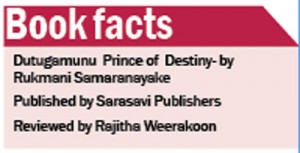Liberation and not racism motivated Dutugamunu the warrior
View(s): Dutugamunu Prince of Destiny (161-137BCE,) the latest literary work of Rukmani Jayasinghe Samaranayake, twice winner of the State Literary Awards, is not merely a historical narration of a warrior prince regaining the kingdom of Rajarata. But it is to right a historical injustice that Dutugamunu set out to defeat the usurper king Elara not due to his race or ethnicity.
Dutugamunu Prince of Destiny (161-137BCE,) the latest literary work of Rukmani Jayasinghe Samaranayake, twice winner of the State Literary Awards, is not merely a historical narration of a warrior prince regaining the kingdom of Rajarata. But it is to right a historical injustice that Dutugamunu set out to defeat the usurper king Elara not due to his race or ethnicity.
The author, captivated by Dutugamunu’s heroism, stresses that Dutugamunu was driven to fight Elara to liberate the oppressed people of Rajarata, safeguard the sacred places as well as rescue the Sangha who remained in Anuradhapura to protect the Buddhist monuments. It was therefore, not racism that motivated him for the liberation.
Arguing that it was a war waged for a righteous cause, the author says that she wrote the book “with reconciliation in mind.” Therefore, details of the writer’s accounts of war-preparations, the selection of the giants, making of weapons, training in martial arts, the intelligence network, strategic moves et al was to focus on the mammoth task Dutugamunu had to counter Elara’s military might. The extensive number of forts erected along the Rajarata border and Elara’s mighty warriors and trained troops demanded elaborate military preparations.
Besides, the Southern Royalty of the House of Vijaya was determined to avenge the usurpation of the Anuradhapura throne from king Asela. Elara killed Asela – a sibling of Devanampiyatissa, inspite of his advanced years and took over the Anuradhapura throne which was looked upon as a degrading act.
The author, who has explored beyond the Mahavamsa to write a celebration of Dutugamunu commences her account with his life in Magama and goes on to Kothmale which Mahavamsa has excluded and his battles ending with his reconciliation measures and his invaluable contribution to the development of the Buddha Sasana as the sovereign monarch. Written in the form of a historical novel, she has interwoven facts, legends and her imaginative skills to build up one of the most descriptive accounts of the famous warrior king of Sri Lanka.
And her lucid style of writing has made a politically turbulent period in history, easy to read. The saga however, is not without intrigue, secret deals, tactical moves and switching of loyalties which reveal that Dutugamunu had to battle it out not only on the field and across the border but also within the Magama royal court.
The tussle for the throne of Ruhuna had not been only between Dutugamunu and Tissa. Dighabhaya, the son of Kavantissa by an earlier marriage and therefore, older than Dutugamunu, had also aspired to the throne.
According to the author, Dighabhaya was a key actor in the politics of the Ruhuna kingdom. He had been assigned to supervise the string of border fortresses by Kavantissa. Therefore, stationed at Kachchattthika Fort on the Mahaveli banks, he monitored fortresses and networked intelligence. Dighabhaya in fact, was the first to inform Kavantissa of the punishment of Elara’s son, his heir, by death.
However, disenchanted Dighabhaya, on learning that he was out of the race for the Southern throne, had been approached by Elara. Dighabhaya switched loyalties on the pledge made by Elara that he would be made sub king of Ruhuna on his military victory. And he defected to Rajarata with the 30,000 troops assigned to him. Consider as to how Elara’s reputation may have enhanced in having Kavantissa’s eldest son serving in his army?
Having thus traded his loyalty, Dighabhaya sent his troops to Tissa to fight Dutugamunu. He sent more troops of Elara on the promise that Dutugamunu be taken prisoner live and handed over to him. Tissa, the winner of the battle instead, kept back the troops with bribes of gold and land and got them to train his troops. Added to Dighabahaya’s woes was his rivalry with Dighajantu – Elara’s powerful army commander and Chief Minister.
The role played by the Sangha at crucial times in this period of history, makes interesting reading. Very moving especially, is the author’s account of how the Sangha saved the day for Dutugamunu during the second battle of the two brothers. The brothers who had broken the oath pledged to the father that they would not fight with each other were on the battlefield for the second time while the oath of neutrality given to king Kavantissa was strictly kept by the warrior giants. Therefore, “in the absence of the giants in the battlefield and on seeing many trained soldiers dying or getting injured, an army of bhikkus, moved into the battlefield, advancing amidst the fighting cadres. The enemy, shocked at seeing the yellow-robed army, moved back respectfully making way for them which afforded Dutugamunu and his troops to retreat. The bhikkus on the field, ministered over the injured and attended to the dead of both brothers.”
For the reconciliation-minded author, the glowing moments of Dutugamunu were those after his conquest when he made his decree for the dead king when he built “the only monument on Earth from a victorious king to a vanquished foe.” He further converted the “Council of War” to the “Council of Peace.” And addressing the warrior giants, he said, “I commit you with the task of making peace meaningful for the people. They need healing both in mind and body. See to all in equal measure without discrimination.”


